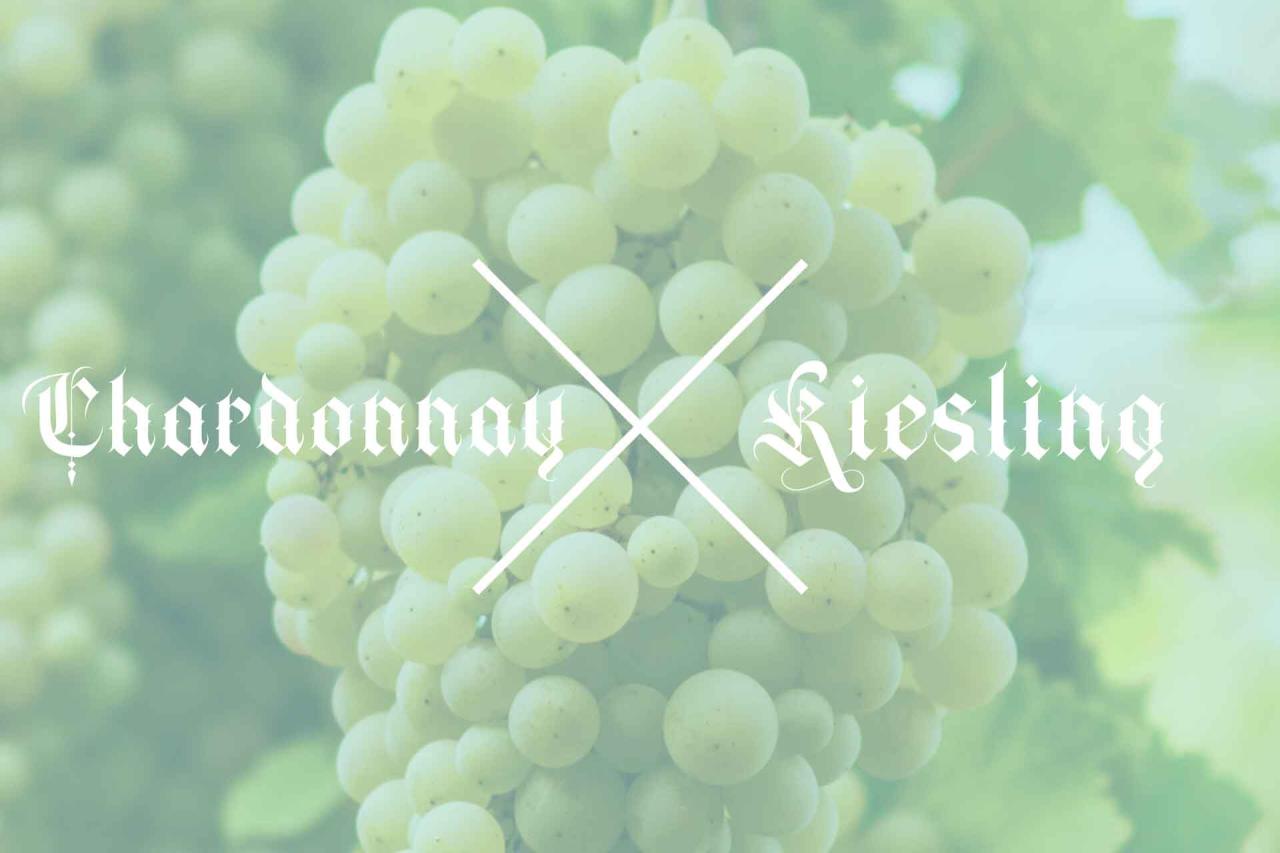Originally from Europe, the cultivation of these two vines then spread throughout the world leading to the creation of wines with different styles. Both Chardonnay and Riesling are able to adapt to the place of production, becoming the pure expression of the terroir and the winemaker. This also makes them particularly ductile and versatile in pairing with food.
But while Chardonnay enjoys great popularity among consumers, Riesling is normally more appreciated by experts in the sector.
The differences between these two wines do not end there. Read on for our article to fully understand the Chardonnay vs Riesling comparison.
Chardonnay vs Riesling
Although they look like two quite similar wines on paper, Chardonnay and Riesling are revealed to be quite different when tasted. Let's see in detail how they are similar and how they differ.
Similarities
Chardonnay and Riesling are two vines of European origin, which thanks to their ability to adapt have spread to many parts of the world. They are considered among the most important grape varieties in the world.
These two vines produce excellent dry white wines widely sold throughout the world.
Thanks to their well-defined character, both wines are easily recognizable by smell and taste.
Chardonnay and Riesling wines both show a fruity character, good acidity, and exceptional aging capacity in higher-end wines such as those from Burgundy for Chardonnay or some German ones for Riesling.
Differences
Although both show fruity aromas, the flavor profile of Riesling veers more towards citrus and green fruit notes, while Chardonnay displays ripe and tropical fruit. Riesling is generally vinified and aged in cement or steel to preserve its natural freshness. This results in the development of typical hydrocarbon scents which allow for easy recognition. Chardonnay, on the other hand, is very often aged in oak, with the consequent development of toasted and buttery notes.
Chardonnay has a rounder and richer body, compared to the lean Riesling. The alcohol content is also decidedly different, basically low for Riesling and medium-high for Chardonnay.
Riesling produces wines of all degrees of sweetness, from bone dry to opulent sweet ones. Chardonnay, despite presenting vaguely sweet fruity notes, is essentially a dry wine.
Both wines are known all over the world, but while Chardonnay has a fascinating charm that easily intrigues even the least expert drinker, Riesling shows a slightly more difficult character that requires patience and the ability to understand the wine and its characteristics.
Comparison chart between Chardonnay and Riesling
| Chardonnay | Riesling | |
|---|---|---|
| Tasting notes | Robust and complex character. Aromas of ripe and tropical fruit, buttery and toasted notes. Lively acidity and good body. | Savory character. Citrus, stone and graphite flavors and even hydrocarbons with age. Remarkable acidity. |
| Sweetness | Dry | Dry to sweet |
| Body | Medium | Light to medium |
| Acidity | Medium | Extremely high |
| Alcohol | Medium to high | Low to medium |
| Age worthiness | 5 to 25 years | 5 to 25 years |
| Cost | $8 to $800 | $10 to $200 |
| Food pairing | fish, molluscs and crustaceans, poultry and light vegetable-based first courses, pork | shellfish, seafood, oysters, sushi, pork |
| Serving temperature | 8-12°C / 46-54°F | 8-12°C / 46-54°F |
Get updates on the latest posts and more from Wine Bugle straight to your inbox.
Taste and flavor
Chardonnay
Chardonnay is a very ductile wine and the terroir of origin, as well as the stylistic choices of the winemaker, can change its character.
When not aged in wood, the bouquet reveals delicate and fruity notes of peach, apple, pear, citrus, caramel, pineapple, and banana, as well as notes of dried fruit, vanilla, and butter. Depending on the soil or origin, certain wines may also show a marked minerality. In case it is aged in wood, more complex spicy notes are also evident.
On the palate, it has a robust and complex character with balanced acidity, a certain roundness and a lingering aftertaste.
Riesling
Riesling is characterized by intense aromas of citrus fruits such as lemon and lime, green apple, hawthorn, wisteria, and chamomile, with a tendency to mineral notes of hydrocarbons with different intensities based on the territory of origin.
The long refinements give this product aromas of butter, honey, wax, and dried fruit as well as a fabulous evolution of the hydrocarbon notes. Botrytis enriches these wines with spicy notes such as saffron and cinnamon.
But the most relevant characteristic of Riesling is its vibrant acidity which balances residual sugars in sweet wines and makes the wine very long-lived.
Origin and history
Chardonnay
Unanimously considered as originating from Burgundy, according to some scholars Chardonnay actually comes from the Middle East. It was certainly planted in Burgundy by the Cistercian monks of the Pontigny abbey.

Riesling
Riesling's elective homeland is Germany where the vine originates. The areas of main interest all wind along the course of the Rhine or the Moselle river.
Where are they produced and in which styles?
Chardonnay
The most prestigious wine-growing area for the production of Chardonnay is Burgundy, especially the Côte de Beaune (southern part of the Côte-d'Or) where the best French Chardonnays come from. These are complex, elegant, and well-structured wines.
Another territory particularly suited to the production of Chardonnay is Chablis, a small region in the northern part of Burgundy. Here, the colder climates and calcareous soils rich in fossil deposits give the Chardonnay an unmistakable mineral sapidity. In the Champagne region, about one-third of the wine production is dedicated to Chardonnay.
In the United States, the most famous Chardonnays are produced in California (Napa Valley and Sonoma County) where this grape benefits from wide temperature ranges and an arid continental climate. The use of high-toasted first-passage barriques means that Californian Chardonnays generally take on decisive nuances of toasted almonds, vanilla, and a soft and round mouthfeel.
Chardonnay is also cultivated with great results in Canada (in particular in Ontario, Quebec, and British Columbia), Australia, New Zealand, South Africa, and Argentina.
Riesling
Riesling is considered one of the finest white grape varieties in the world. Its elective homeland is Germany, where it is still today the most widespread grape variety, especially in the Moselle, Palatinate, and Rheingau.
In Alsace, where it produces more full-bodied, fruity, and alcoholic wines, the most important area is that of the Upper Rhine with vineyards facing east.
In recent times, Riesling is also gaining ground in Australia and New Zealand. In New Zealand, late-harvest wines are made with grapes affected by Botrytis Cinerea. In Australia, it is preferred to vinify it dry with the potential for aging in the bottle. In Canada, it is used to make Icewine.
Sweetness/dryness comparison
When it comes to the difference between Riesling and Chardonnay, sweetness and dryness are key factors. In fact, while Riesling wines can be sweet, semi-sweet, or dry, Chardonnays are usually dry wines.
Alcohol content comparison
In terms of alcohol, the comparison of Riesling vs Chardonnay is won by Chardonnay which has a higher alcohol content than Riesling even if coming from cold climate areas.
Food pairing
These two wines have a series of characteristics that make them quite similar when paired with food. And not just because they are white wines. These are wines with a good acid note and excellent complexity.
Chardonnay
Thanks to its excellent acid vein and its good structure, Chardonnay goes deliciously with dishes with a good fat component such as salmon and fries.
The younger and unoaked wines pair deliciously with dishes with a sweet tendency such as shellfish, with white fish or sushi.
The more complex versions are perfect with rich pasta dishes like tagliatelle with porcini mushrooms or pasta carbonara. Also excellent with white meats, chicken, or roast turkey, and in the case of full-bodied wines with pork, especially if served with an apple sauce.
Riesling
There are countless food pairings in which Riesling is considered the perfect wine.
The fresh versions are excellent aperitifs, and pair well with fish, especially mollusks, shellfish, and crustaceans as their mineral notes blend perfectly with the iodized flavor of fish. Riesling is also one of the most requested wines in Japan because it goes very well with sushi.
For Alsatian wines, the classic pairings are with the local recipes choucroute, matelote, and palette de porc fumée.
However, Riesling wines also work deliciously with poultry, white meats in general, and goat cheeses.
Sweet wines and late harvests go well with sweets and desserts such as citrus ftarts and lemon cake.
Wines to try under $50
There is plenty of choice on the market among Chardonnays and Rieslings. Here we chose some of those that we believe are most representative of these two grape varieties.

Chardonnay
Domaine Remi Jobard Bourgogne Cote d'Or Blanc Vieilles Vignes, France
Billaud-Simon Chablis, France
Old Soul Vineyards Chardonnay, USA
Leeuwin Estate Prelude Vineyards Chardonnay, Australia

Riesling
Loewen Longuicher Herrenberg Riesling Kabinett, Germany
Grosset Alea Riesling, Australia
Kuentz-Bas Riesling Grand Cru Geisberg, France
Eroica Riesling, USA

